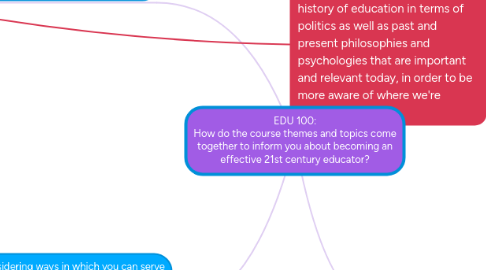
1. Understanding the structures and institutions that govern education in Alberta
1.1. Political Structure and Policies
1.1.1. Text: Control of Public Education (Allison, Gidney, & Paquette, 1984): Explains the history of education and the government, and how it has come to be.
1.1.1.1. Reflection: I think it is important that we as upcoming teachers know about the history and political side of education as we progress through our teacher education as it is important to know history and how education has come to be today.
1.2. Paradigm of Education
1.2.1. Video: Changing Education Paradigm (The RSA, 2010): Explores the way we view education as an institutionalized and standardized environment.
1.2.1.1. Reflection: I thought is was great that this video challenged the way society has created education as a standardized industry, and made me think to be conscious of this and how students might put themselves down because of this, as well as how students learn in different ways such as in groups, individually, in a creative manner, or in a more logical manner, since it is something we need to be actively aware of as teachers.
2. Exploring current issues in education
2.1. Socialism
2.1.1. Class Notes: Socialism (Maheu, Oct 28, 2014): "Our systematic training into the norms of our culture; process of learning the meanings and practices that enable us to make sense of and behave appropriately in our culture"
2.1.1.1. Reflection: I believe that as teachers we need to always be consciously aware of the effects of socialism within the school and in our classrooms, especially in our growing world which is become more and more diverse. There will always be a diverse culture in any classroom, so the teacher always has to be aware of the different students cultures, perspectives values, and beliefs.
2.2. Diversity
2.2.1. Lecture: Sexual and Gender Minority Students: GLBTQ Issues (Phair, 2014, Nov. 6): Explores issures related to the LGBTQ community and instances were they neglected or bullied, and how we as teachers are able to prevent it and control it.
2.2.1.1. Reflection: It is evident that the LGTBQ community is becoming an increasingly discussed topic as more and more people become educated about who they are and how (some) are being treated on a day to day basis. As teachers we are going to have to be active agents of change in order to embrace not just them but any minority, and to be able to create a safe environment for all students.
3. Considering ways in which you can serve as an agent of change in schools/education
3.1. Inclusion of Minority Students
3.1.1. Activity: Collaborate Jigsaw (Here comes Everyone): Exploring many different perspectives of diversity in education.
3.1.1.1. Reflection: I enjoyed this activity because when we had to think about the situations, we also challenged our assumptions about the situations through thinking through it, as well as working collaboratively because we saw how others responded to the situations and in a way saw their reasoning and perspective.
3.1.1.1.1. Connection: In my 'expert group' where we explored chapter 1, one of our big take away was that we as teachers have to know where we come from as well as how we've changed over time, which is not only a parallel to the article by Peters (1991), but also to your introduction assignment, the biography (Sep 11, 2014). This allowed us to explore who are are at this point in time in relation to who you are as a person as well as as a teacher, since that was something we had to discuss. If we looked back at it now and later on in our teacher education, we would probably see how much our perspectives have changed.
4. Developing your professional identity
4.1. Text: Your Philosophy of Education (Loomis & Martin, 2014): Explaining educational philosophies and psychologies.
4.1.1. Reflection: In order to begin developing our identities as teachers, we have to be knowledgeable on different ways of approaching teaching, and make up our minds, through discussion on different methods, which way you believe will be the best approach and the most effective method to teach.
4.2. Reading: Strategies for Reflective Practice (Peters, 1991): Explores the concept and process of being a reflective practitioner.
4.2.1. Reflection: I thought this was a very interesting reading as even though I never thought about it in so many words, I have always thought that just in life, you are constantly put in different situations where you have to make choices that shape who you are and that you are always changing and learning by the experiences you go through and the choices you make.
